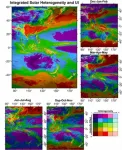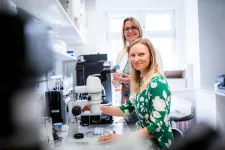(Press-News.org) COLUMBUS, Ohio – A proposed artificial intelligence tool to support clinician decision-making about hospital patients at risk for sepsis has an unusual feature: accounting for its lack of certainty and suggesting what demographic data, vital signs and lab test results it needs to improve its predictive performance.
The system, called SepsisLab, was developed based on feedback from doctors and nurses who treat patients in the emergency departments and ICUs where sepsis, the body’s overwhelming response to an infection, is most commonly seen. They reported dissatisfaction with an existing AI-assisted tool that generates a patient risk prediction score using only electronic health records, but no input data from clinicians.
Scientists at The Ohio State University designed SepsisLab to be able to predict a patient’s sepsis risk within four hours – but while the clock ticks, the system identifies missing patient information, quantifies how essential it is, and gives a visual picture to clinicians of how specific information will affect the final risk prediction. Experiments using a combination of publicly available and proprietary patient data showed that adding 8% of the recommended data improved the system’s sepsis prediction accuracy by 11%.
“The existing model represents a more a traditional human-AI competition paradigm, generating numerous annoying false alarms in ICUs and emergency rooms without listening to clinicians,” said senior study author Ping Zhang, associate professor of computer science and engineering and biomedical informatics at Ohio State.
“The idea is we need to involve AI in every intermediate step of decision-making by adopting the ‘AI-in-the-human-loop’ concept. We’re not just developing a tool – we also recruited physicians into the project. This is a real collaboration between computer scientists and clinicians to develop a human-centered system that puts the physician in the driver’s seat.”
The research was published Aug. 24 in KDD ’24: Proceedings of the 30th ACM SIGKDD Conference on Knowledge Discovery and Data Mining and will be presented orally Wednesday (Aug. 28) at SIGKDD 2024 in Barcelona, Spain.
Sepsis is a life-threatening medical emergency – it can rapidly lead to organ failure – but it’s not easy to diagnose because its symptoms of fever, low blood pressure, increasing heart rate and breathing problems can look like a lot of other conditions. This work builds upon a previous machine learning model developed by Zhang and colleagues that estimated the optimal time to give antibiotics to patients with a suspected case of sepsis.
SepsisLab is designed to come up with a risk prediction quickly, but produces a new prediction every hour after new patient data has been added to the system.
“When a patient first comes in, there are many missing values, especially for lab tests,” said first author Changchang Yin, a computer science and engineering PhD student in Zhang’s Artificial Intelligence in Medicine lab.
In most AI models, missing data points are accounted for with a single assigned value – a process called imputation – “but the imputation model could suffer from uncertainty that can be propagated to the downstream prediction model,” Yin said.
“If the imputation model cannot accurately impute the missing value and it’s a very important value, the variable should be observed. Our active sensing algorithm aims to find such missing values and tell clinicians what additional variables they might need to observe – variables that can make the prediction model more accurate.”
Equally important to removing uncertainty from the system over the passage of time is providing clinicians with actionable recommendations. These include lab tests rank-ordered based on their value to the diagnostic process and estimates of how a patient’s sepsis risk would change depending on specific clinical treatments.
Experiments showed adding 8% of the new data from lab tests, vital signs and other high-value variables reduced the propagated uncertainty in the model by 70% – contributing to its 11% improvement in sepsis risk accuracy.
“The algorithm can select the most important variables, and the physician’s action reduces the uncertainty,” said Zhang, also a core faculty member in Ohio State’s Translational Data Analytics Institute. “This fundamental mathematics work is the most important technical innovation – the backbone of the research.”
Zhang sees human-centered AI as part of the future of medicine – but only if AI interacts with clinicians in a way that makes them trust the system.
“This is not about building an AI system that can conquer the world,” he said. “The center of medicine is hypothesis testing and making decisions minute after minute that are not just ‘yes’ or ‘no.’ We envision a person at the center of the interaction using AI to help that human feel superhuman.”
This research was supported by the National Science Foundation, the National Institutes of Health and an Ohio State President’s Research Excellence Accelerator Grant. Zhang has received additional NIH funding to continue collaborating with clinicians on this work.
Additional co-authors include Jeffrey Caterino of The Ohio State University Wexner Medical Center, Bingsheng Yao and Dakuo Wang of Northeastern University, and Pin-Yu Chen of IBM Research.
#
Contact: Ping Zhang, Zhang.10631@osu.edu
Written by Emily Caldwell, Caldwell.151@osu.edu; 614-292-8152
END
At the MIT Press, we believe that everyone deserves access to scholarship. Our dedication to this mission remains strong as we head into the fourth funding cycle for Direct to Open (D2O), our model for open access monographs. Libraries and consortia can commit to support the program through November 30, 2024.
“Direct to Open is a game changer,” said Amy Brand, Director and Publisher at the MIT Press. “We know that open scholarship benefits authors, readers, and the academy at large. This is why we ...
A study finds an increased risk of developing a productive SARS-CoV-2 infection in obese people. Obesity is known to predict worse outcomes and higher mortality for those with COVID-19. Masanori Aikawa and colleagues sought to determine if obesity also affected the likelihood of getting ill in the first place. To investigate, the authors analyzed electronic medical records for 687,813 patients from the Mass General Brigham healthcare system, including 72,613 individuals with suspected SARS-CoV-2 exposure, 18,447 of whom tested positive. The authors limited their data to a timeframe before vaccination became widespread in Massachusetts, to avoid the possible confounding ...
A close reading of Darwin’s work suggests a deep interest in cyclical events. Rhythmic phenomena in nature—today the subjects of the field of chronobiology—have been studied since at least the 18th century. In a perspective, Tiago Gomes de Andrade and Andrew D. Beale examined the writings and work of Charles Darwin to explore and share the eminent naturalist’s deep fascination with biological rhythms. Darwin’s work on the “sleep movements” in plants, published in 1880 with his son Francis is well known. This work examined the daily cycle of opening and closing of leaves. But as far ...
Amidst the ongoing energy crisis and under the threat of climate change, exploiting renewable energy sources has quickly become a global necessity. Though our options are varied, solar energy seems to be our best bet—experts estimate that it may become our main energy source well before the turn of the century.
Despite its clear advantages, solar energy generation has some limitations. Much like the wind, solar irradiance in a given region can vary quickly depending on weather conditions, causing fluctuations in power ...
Sophia Antipolis, France – 27 August 2024: Cardiovascular disease (CVD) remains the most common cause of death across Europe but while CVD mortality rates are generally decreasing, the decline is much less in middle-income than in high-income countries, according to new data from the European Society of Cardiology (ESC) Atlas of Cardiology, published in the European Heart Journal.1
The fourth edition of ESC Atlas statistics again demonstrate that CVD is the most common cause of death in the 55 ESC member countries studied. There are over 3 million deaths due to CVD per year – the equivalent of 8,500 deaths per day – which represents 37.4% of all deaths annually. ...
Researchers from the Institute of Organic Chemistry and Biochemistry of the Czech Academy of Sciences, in cooperation with colleagues from the Faculty of Tropical AgriScience of the Czech University of Life Sciences in Prague, are unravelling the mysteries of the life of termites. Colonies of the species Neocapritermes taracua boast a unique type of defence, which is provided by worker termites at the end of their lives. When attacked, they sacrifice themselves by setting off an explosive chemical reaction, the ...
PULLMAN, Wash. – While meant to simulate wood bats, regulation USA Baseball metal bats are more forgiving than wood for young players who might not connect with the ball on a bat’s optimal “sweet spot.”
After testing wood bats and two types of metal bats with youth players, Washington State University researchers found that the exit speed of a hit ball was as much as 5% faster with metal bats over wood. Analyzing the data, they found that the performance of the USA Baseball metal bats at the sweet spot was similar to wood. It was when the hits were on less optimal areas that there was a bigger difference.
“There’s ...
Researchers at the Centre for Genomic Regulation (CRG), the University of the Basque Country (UPV/EHU), Donostia International Physics Center (DIPC) and the Fundación Biofisica Bizkaia (FBB, located in Biofisika Institute) have developed an artificial intelligence which can differentiate cancer cells from normal cells, as well as detect the very early stages of viral infection inside cells. The findings, published today in a study in the journal Nature Machine Intelligence, pave the way for improved diagnostic techniques and new monitoring strategies for disease.
The tool, AINU (AI of the NUcleus), scans high-resolution images of cells. The ...
London, United Kingdom – 27 August 2024: Clinical follow-up using virtual voice technology helped identify complications after transcatheter aortic valve implantation (TAVI) with a high degree of patient satisfaction, according to research presented at ESC Congress 2024.1
Explaining the rationale for the development of the virtual voice assistant for TAVI patients, study author Dr. Marta Herrero Brocal from the Dr. Balmis General University Hospital of Alicante, Spain said: “Aortic valve stenosis is common, especially in the ageing population.2 It can be treated with surgery ...
London, United Kingdom – 27 August 2024: Research from two studies in different European cities1,2 highlights that urban noise pollution has a significant negative impact on heart health, according to data presented at ESC Congress 2024.
“The DECIBEL-MI study shows that young patients aged 50 years or less who had a myocardial infarction (MI) had been exposed to higher levels of noise than the general population. The study demonstrates that urban noise could significantly increase the risk of early-onset MI in young people with low traditional risk factors. Including ...



